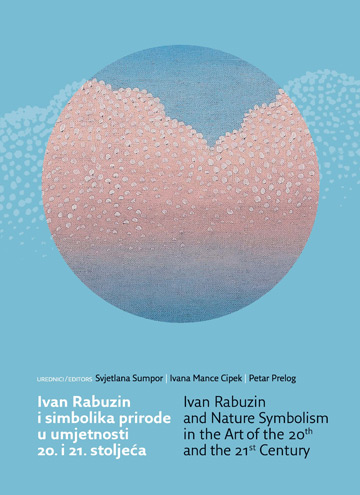Ivan Rabuzin and Nature Symbolism in the Art of the 20th and the 21st Century

Publishers
Croatian Museum of Naive Art – Institute of Art History, Zagreb, October 2023
For the publishers
Nataša Jovičić
dr. sc. Katarina Horvat-Levaj
Editors
dr. sc. Svjetlana Sumpor
dr. sc. Ivana Mance Cipek
dr. sc. Petar Prelog
Peer review
dr. sc. Sandra Križić Roban
dr. sc. Dalibor Prančević
Croatian copy editing
Isidora Vujošević
English translation
Graham McMaster
Graphic design
Mario Aničić
Printing press
Stega tisak d.o.o., Zagreb
Print run
500 primjeraka / copies
Typography
Fresco Sans, Fred Smeijers, 2003
Lumin Sans, Nikola Đurek, 2013
Material description
255 pp.; ilustr.
ISBN IPU 978-953-373-032-5
-
“Diverse in tone and in the premises that underlie their discussions, the authors represented in this book depart to a great extent from previous interpretation strategies, seeing Rabuzin's work from, for example, the stances of literary history, from eco-cultural-geographical points of departure that focus on the natural space, which, of course, is seen as cultural construct rather than as an innocent but in reality non-existent imaginary space of contentment and pleasure. Contemporary terminology, such as that of the eco-critical perspective, as well as a distancing from Rabuzin himself in order to bring other artists into the field of research, those inclined to phantasms that arise as kinds of methods of resistance in a given period, the use of a semiotic system of signs, or an entirely contemporary artistic idiom, created in a time that is apparently not predisposed to bring nature into artistic practice – tell of the expansion of the area of interest in which Rabuzin is a central figure, or at least that landmark whose practice has enabled other artists to draw on his poetic world for certain individual strategies that they have gone on to develop. (…) Thanks to the breadth of the individual approaches, this research principle has resulted in an important consideration of the role of nature in the works of contemporary artists, not only at the level of symbol but more widely as well, by allowing into the areas of art history and the visual arts an interdisciplinary system of thinking that does not submit to the rules or boundaries of just a single discipline.”
From the review by dr. sc. Sandra Križić Roban
-
“The works open up a space for new readings of Rabuzin's works by putting them into a context with works by other artists and with contemporary artistic practices, new critical and theoretical platforms; they make possible a completely different positioning of the appearance of Ivan Rabuzin on the Croatian artistic and overall cultural scene. (...) Although there are separate catalogue texts and monographs on the life and work of Ivan Rabuzin (and naive art in Croatia), this collection sets off new questions that are important for both the discipline and the general public. (...) The particular scholarly contribution of this collection lies in the analysis and interpretation of insufficiently discussed segments of the rich artistic oeuvre of Ivan Rabuzin, as well as of some of his contemporaries, and the recognition of connections with current artistic practices. The new critical readings facilitate a contemporary view of the artist's position in the broader artistic and cultural context.”
From the review by dr. sc. Dalibor Prančević
-
Content
10
Uvod
Introduction
20
Ivana Mance Cipek
Retorika slike Ivana Rabuzina
The Rhetoric of a Painting by Ivan Rabuzin
42
Ivana Bašičević Antić
Ivan Rabuzin – od tumačenja Miće Bašičevića do danas
Ivan Rabuzin – From the Interpretation of Mića Bašičević to the Present Day
66
Igor Loinjak
Krajolik kao topos – prilog razumijevanju Rabuzinovih krajolika
Landscape as Topos – a Contribution to the Understanding of Rabuzin’s Landscapes
92
Vinko Srhoj
Umnogostručeni krajolik Ivana Rabuzina ili o geometrijskom uzorkovanju
The Multiplied Landscape of Ivan Rabuzin or on Geometrical Patterning
112
Vesna Delić Gozze
Ivan Rabuzin / Slikanje „rastriranog“ poretka
Ivan Rabuzin / Painting a Rasterized System
140
Goran Đurđević, Suzana Marjanić
Rabuzinovo stablo: priroda bez društva
Rabuzin’s Tree: Nature without Society
164
Petar Prelog
Priroda u djelima slikara Udruženja umjetnika Zemlja (1929. – 1935.)
Nature in the Works of Painters of the Zemlja Association of Artists (1929-1935)
192
Snježana Pavičić
Čudovišni pejzažno-prostorni detalji s ratnih grafika Marijana Detonija i crteža Josipa Seissela (1940. – 1945.)
Monstrous Space and Landscape Details from the Wartime Graphic Art of Marijan Detoni and the Drawings of Josip Seissel (1940–1945)
214
Mihaela Cik
Rabuzinovi bregi i Lackovićeve ravnice: odjeci zavičaja u crtežima Ivana Rabuzina i Ivana Lackovića Croate
Rabuzin’s Hills and Lacković’s Plains: Echoes of the Native Place in the Drawings of Ivan Rabuzin and Ivan Lacković Croata
244
Klara Macolić
Nerealizirani projekt Galerije Rabuzin u Varaždinu arhitekta Vjenceslava Richtera
The Unbuilt Design of Architect Vjenceslav Richter for a Rabuzin Gallery in Varaždin
272
Helena Kušenić
Paralelizam umjetničkih vizija i (trans)formacija krajolika
A Parallelism of Artistic Visions and Trans-Formations of Landscapes
300
Svjetlana Sumpor
Utopijsko i distopijsko u likovnoj umjetnosti / Stvaralaštvo Ivana Rabuzina kao primjer utopijskog u likovnoj umjetnosti
Utopian and Dystopian in the Visual Arts / The Work of Ivan Rabuzin as Example of the Utopian in the Visual Arts
330
Vana Gović Marković, Ksenija Orelj
Dvoznačnost prirode u suvremenoj umjetnosti – slučaj Mirne Kutleša i Igora Eškinje
The Ambiguity of Nature in Contemporary Art – the Case of Mirna Kutleša and Igor Eškinja
-
The project has been funded by the Ministry of Culture and Media of the Republic of Croatia and the Ministry of Science and Education of the Republic of Croatia.